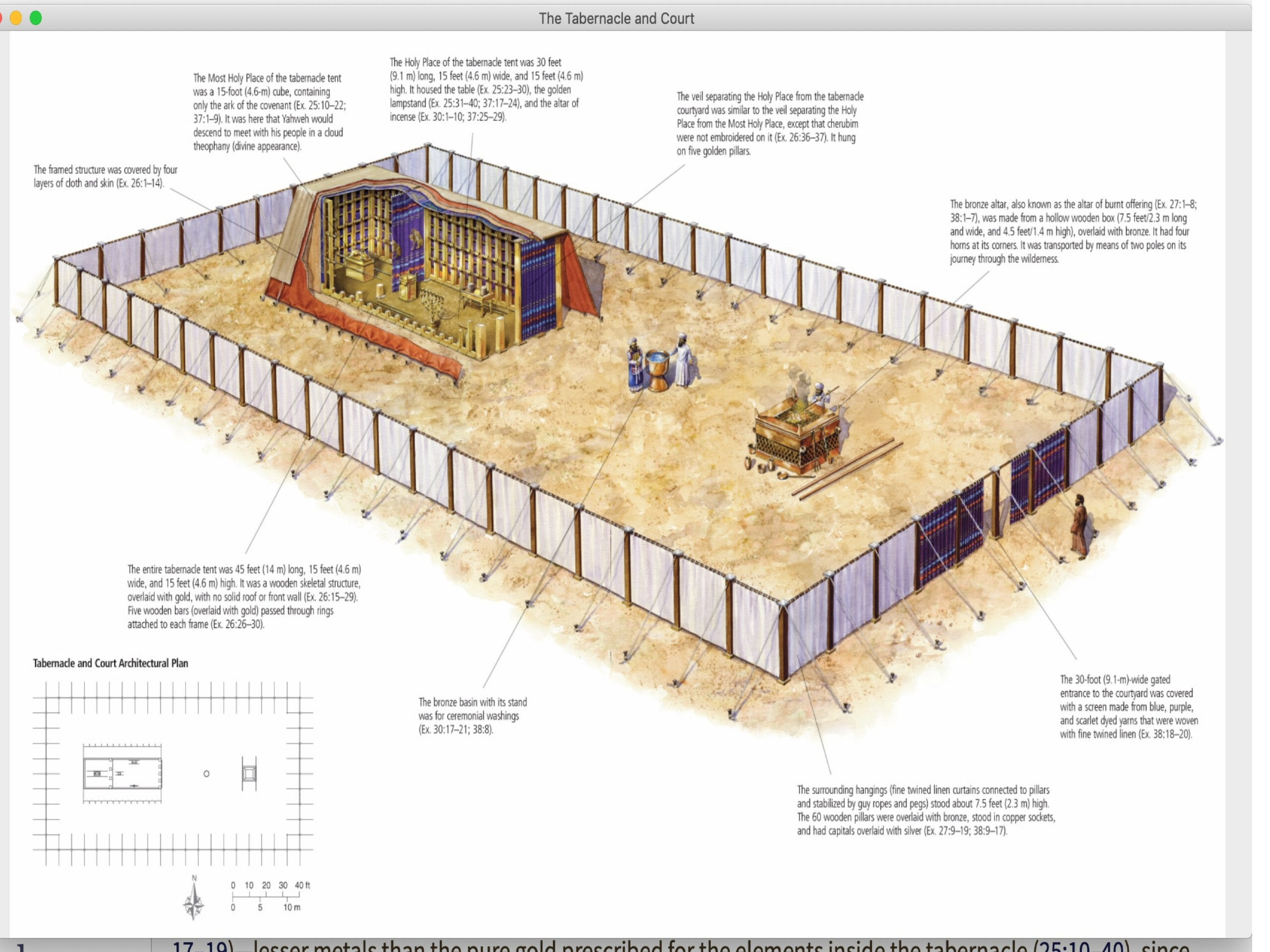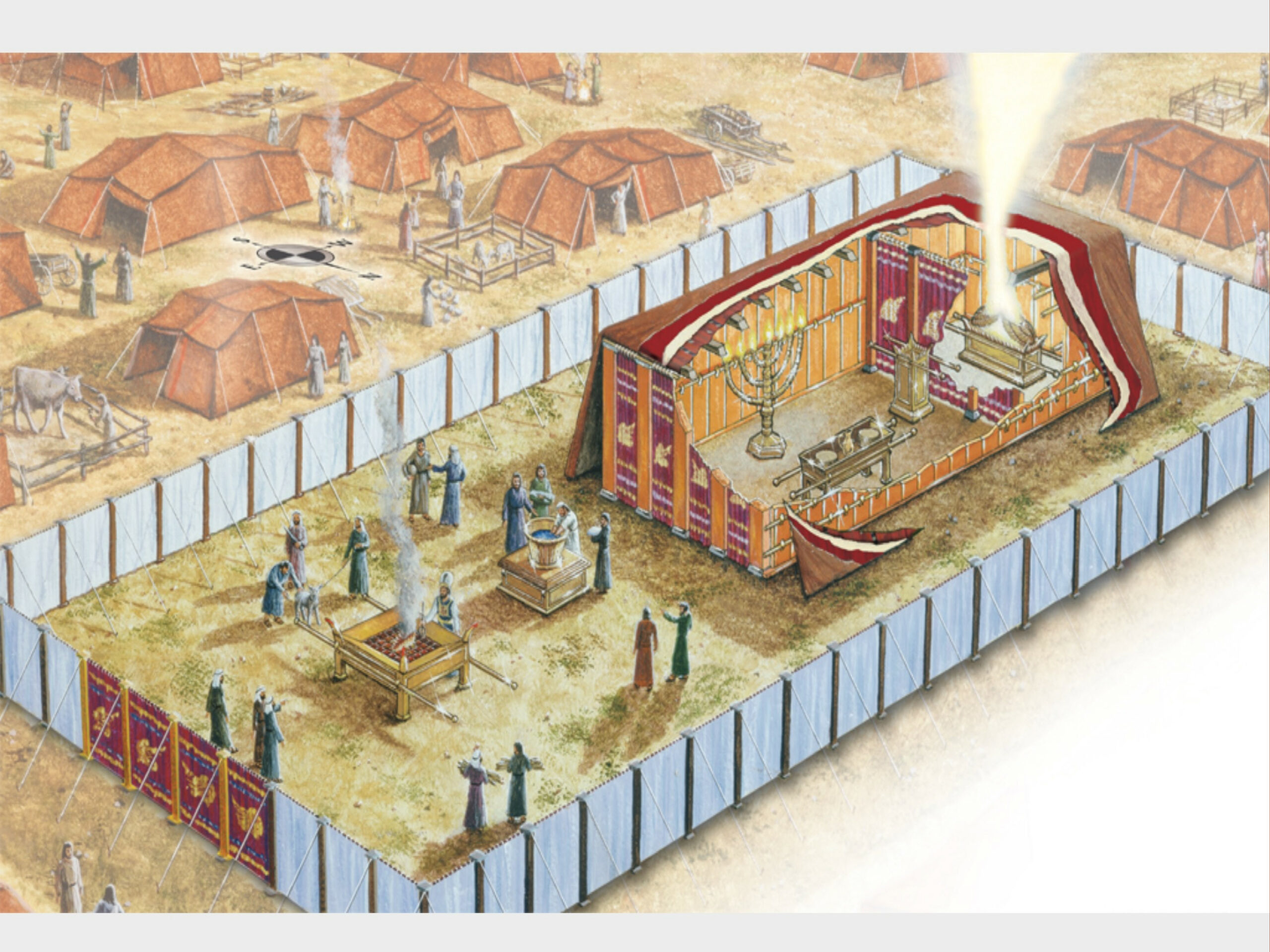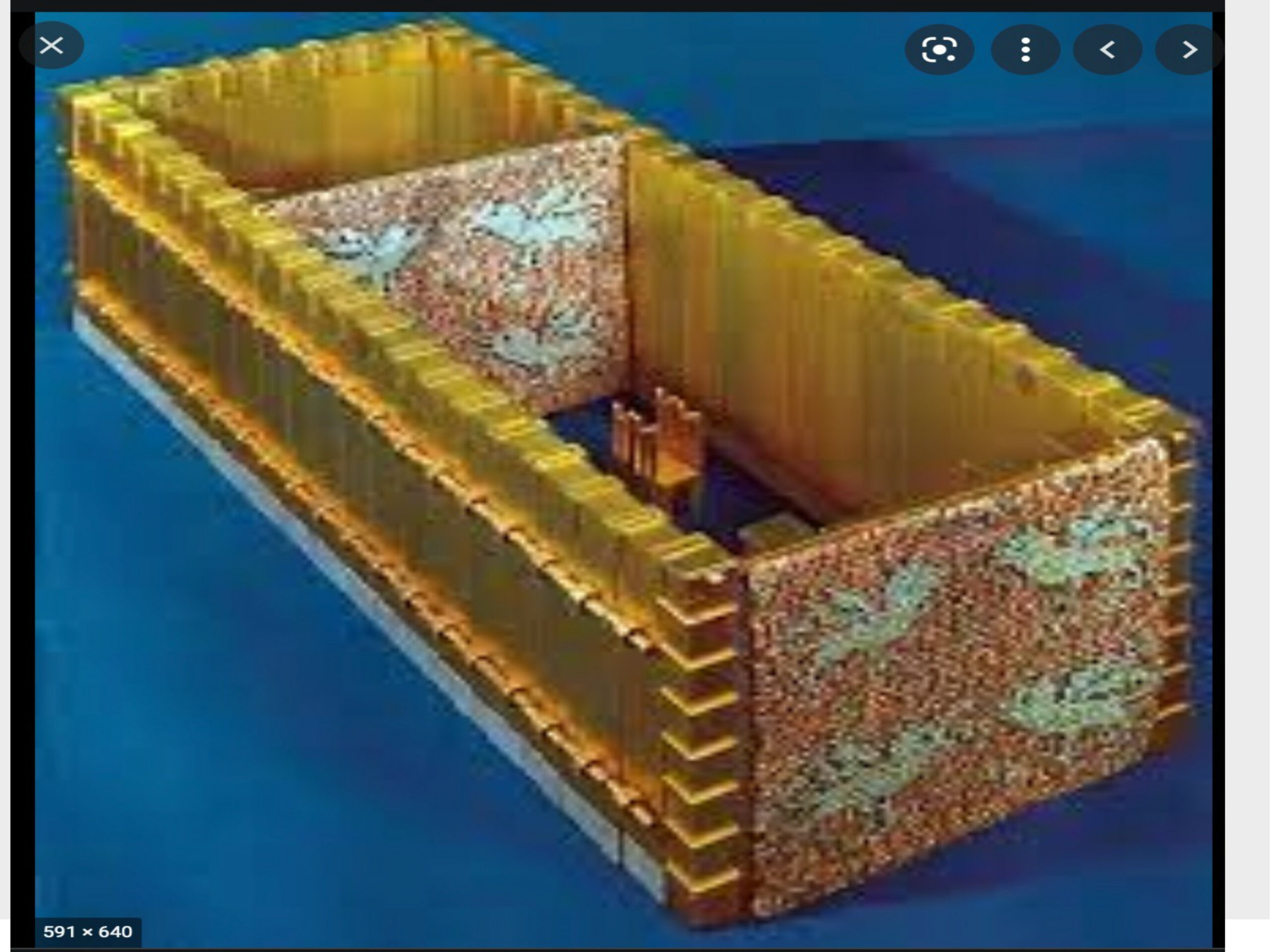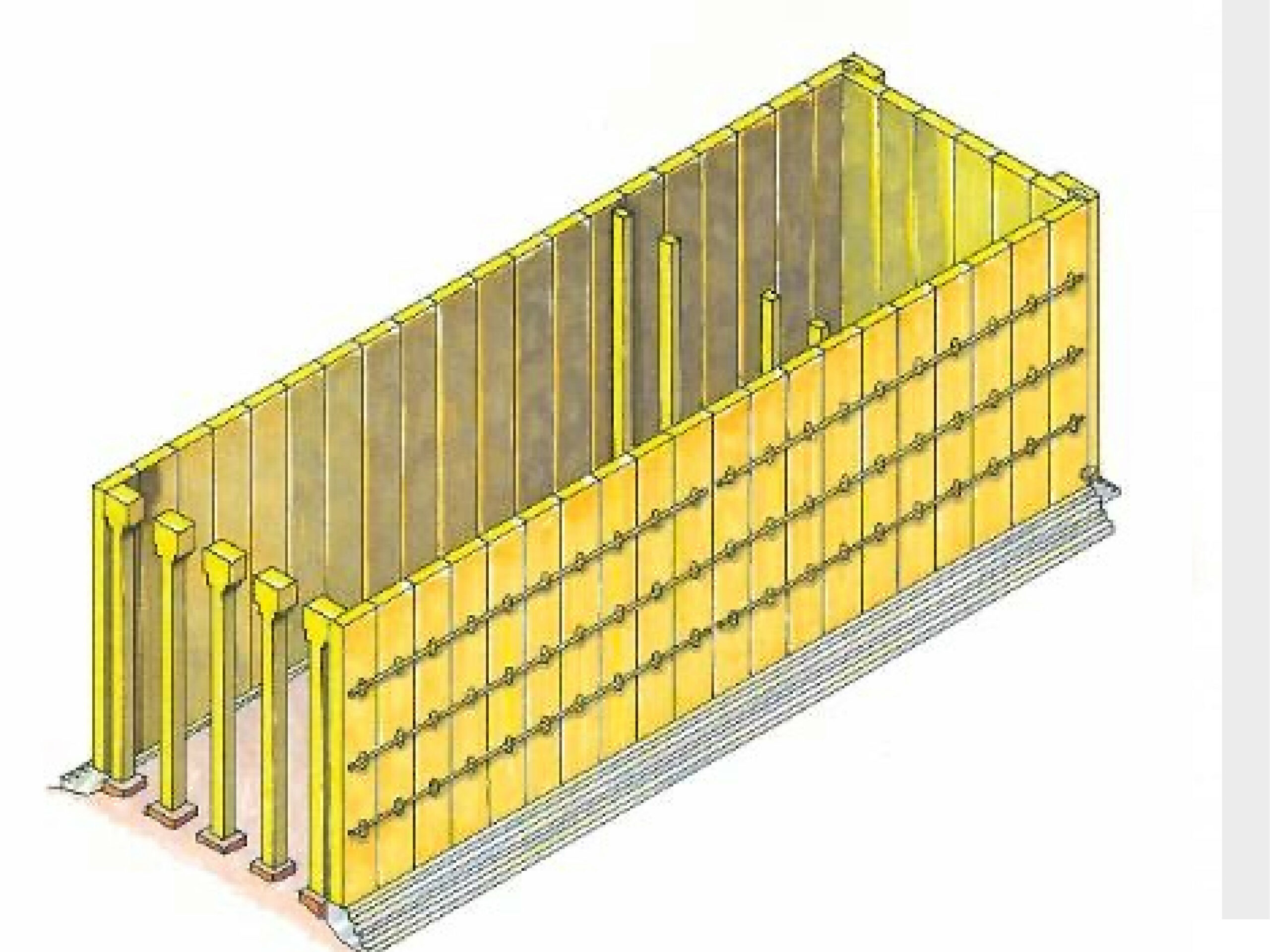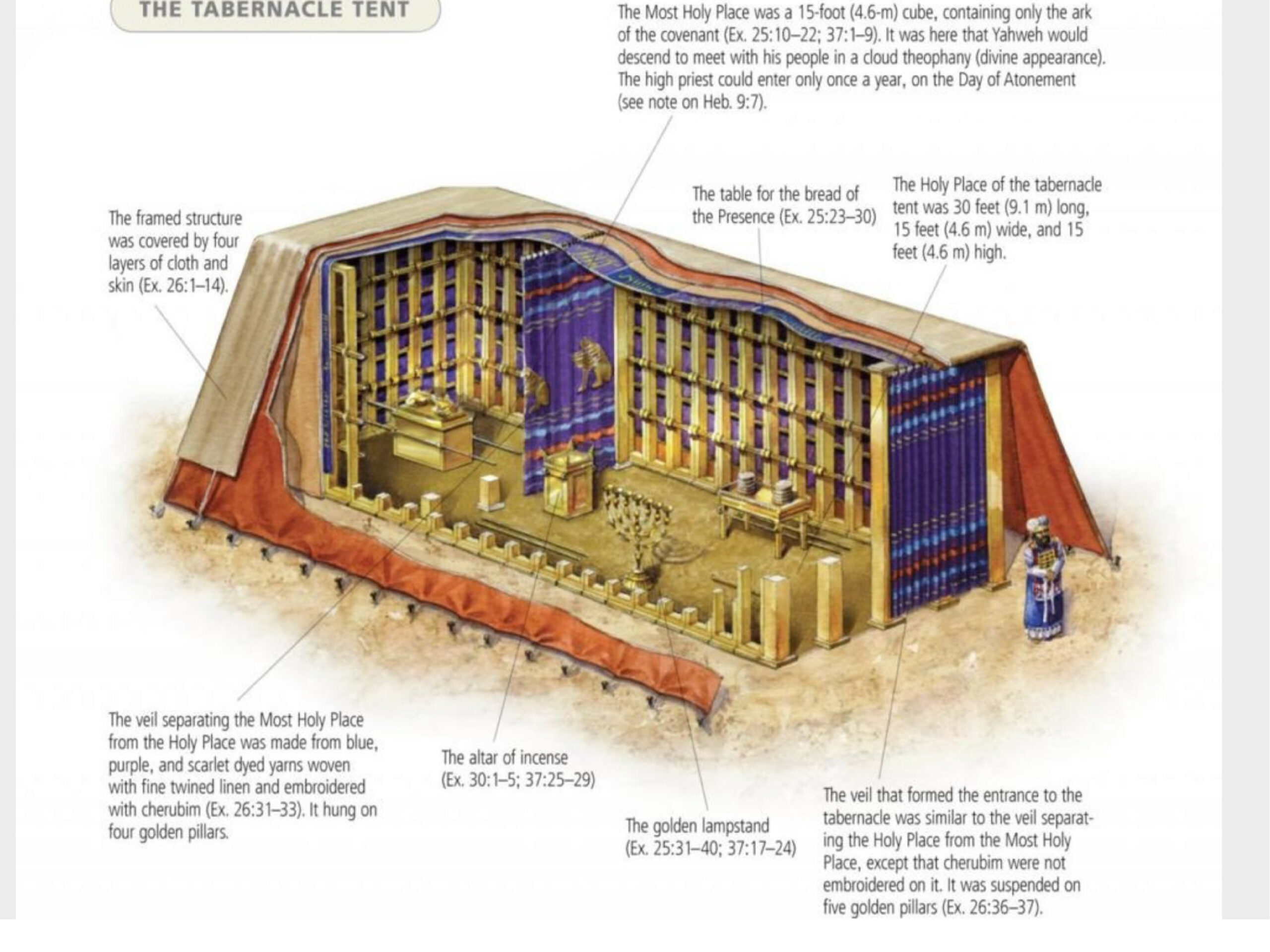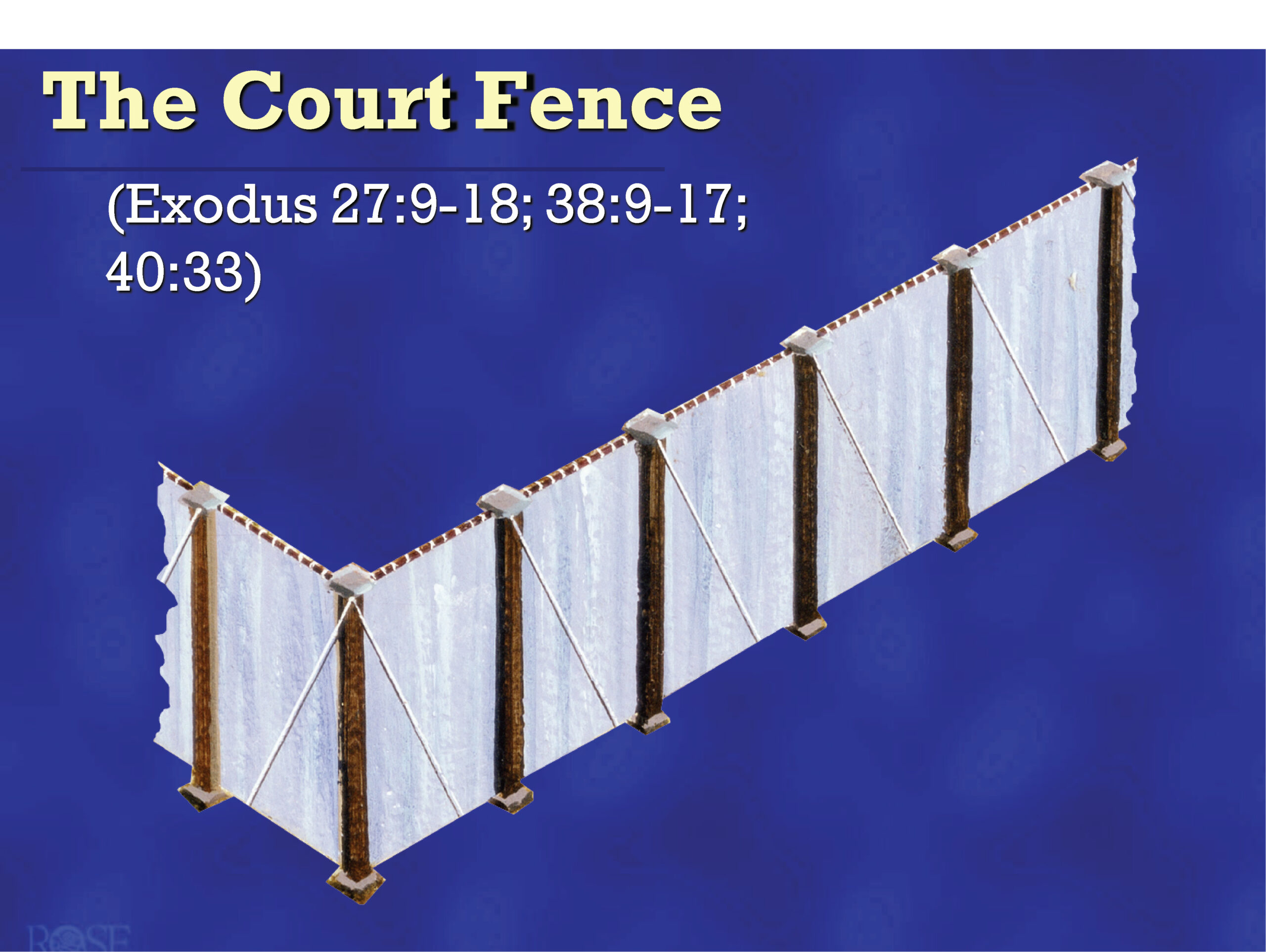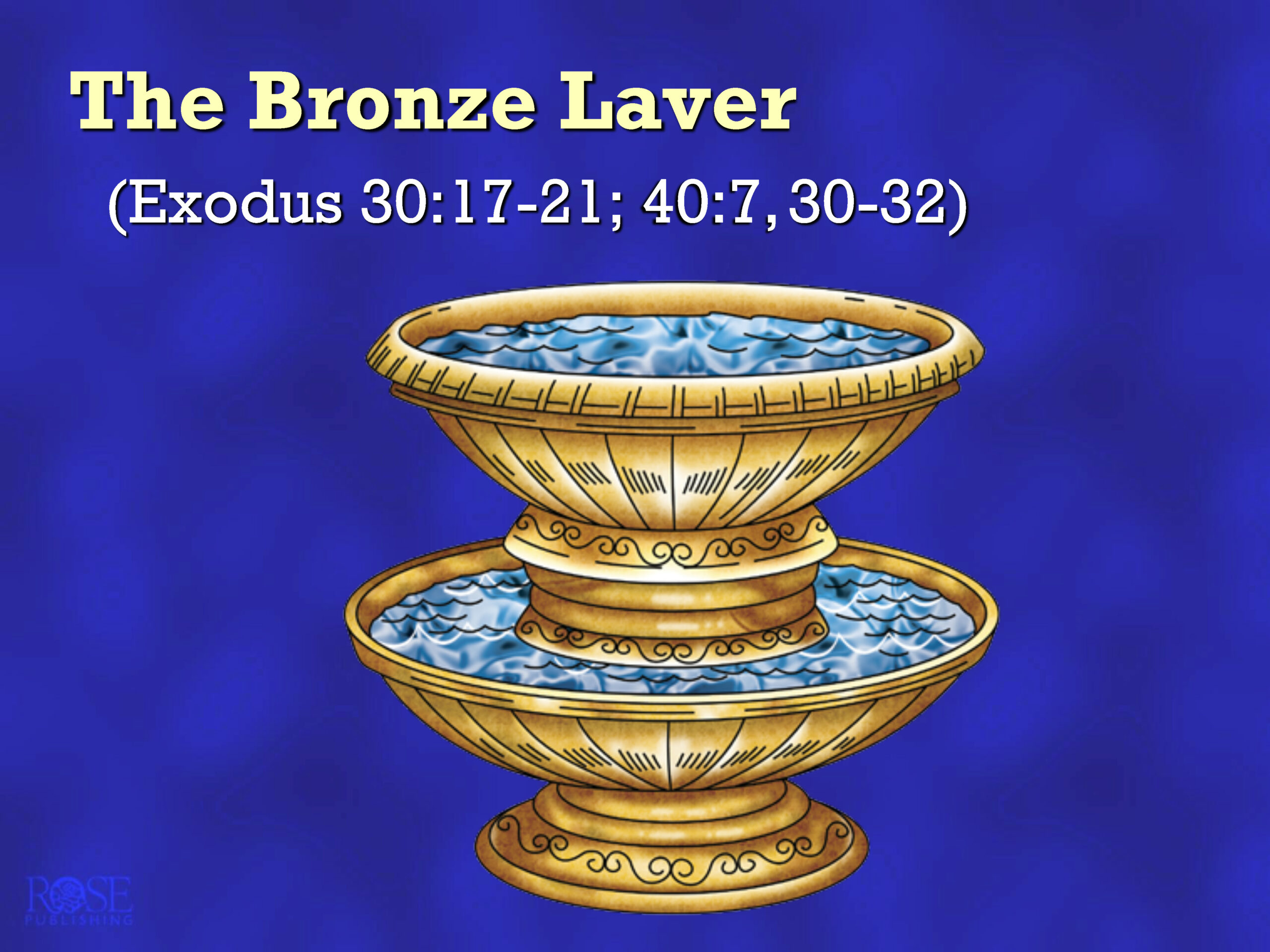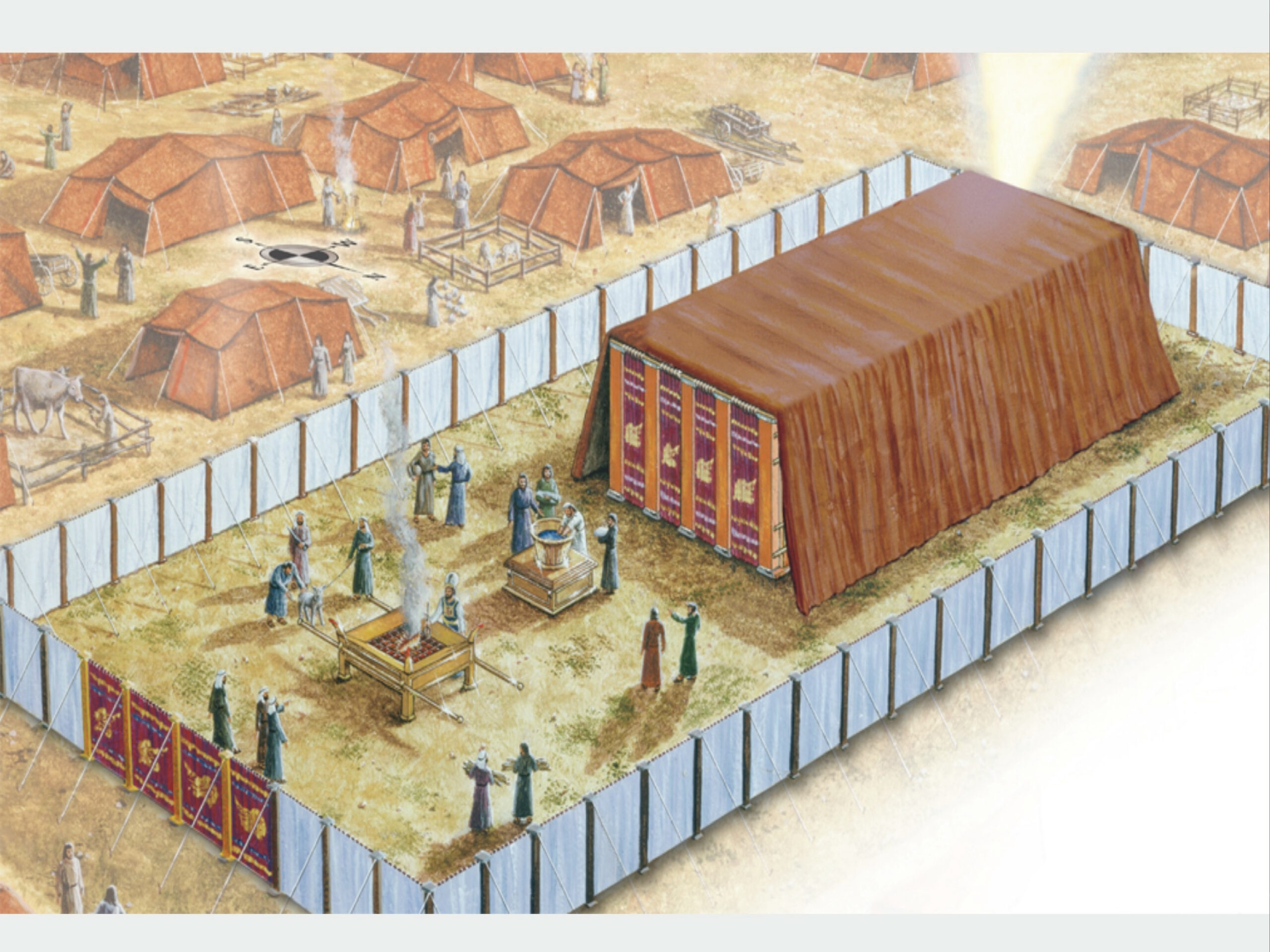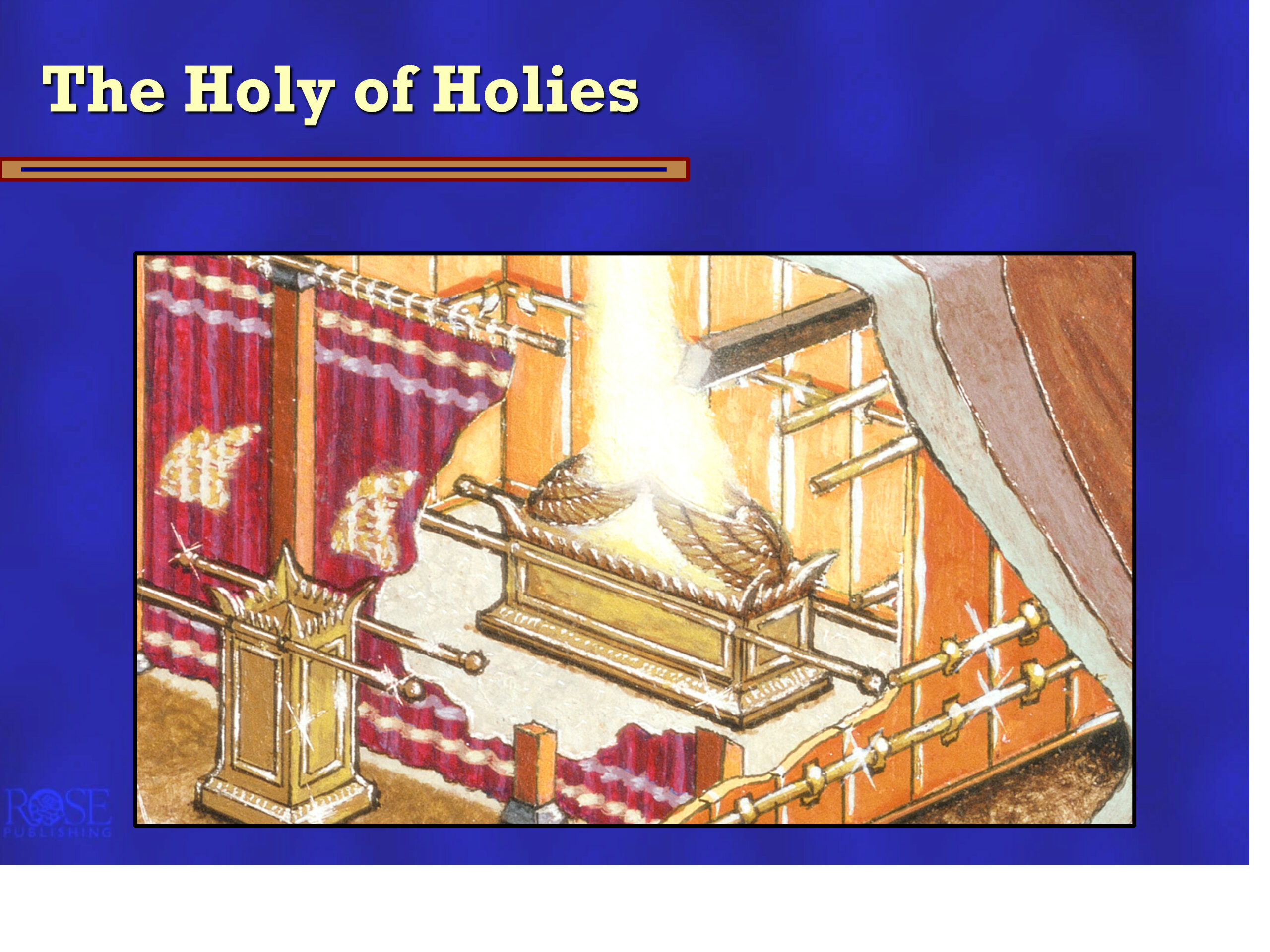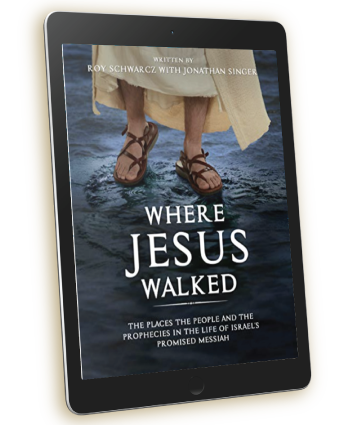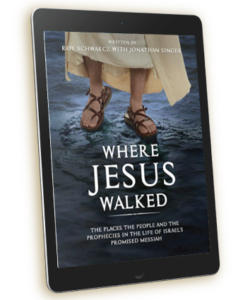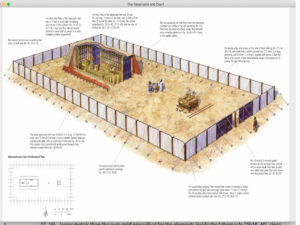
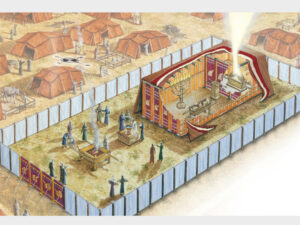
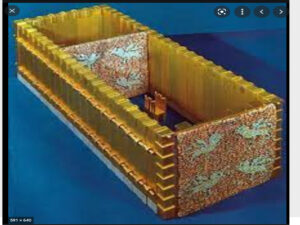
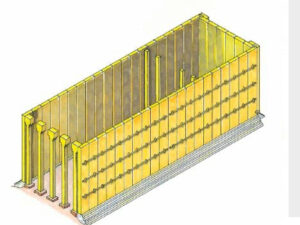
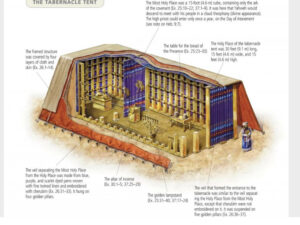
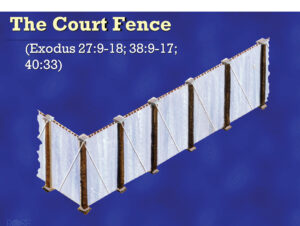
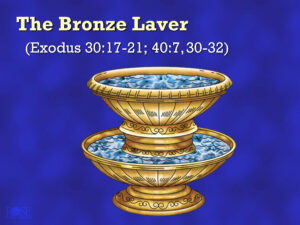
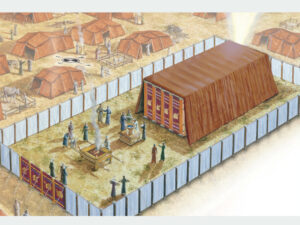
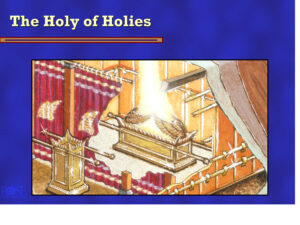
Exodus 26:1-6 We study the Tabernacle to understand God’s pattern of worship. The Tabernacle shows how sinful man can have fellowship with a holy God. The Hebrew word for tabernacle is mishkan, (“dwelling place.”) The tabernacle was a tent in which God dwelt among his people. It was set in the center of the tribes of Israel. When he led them in the form of the pillar of cloud/fire. But when camped, He dwelt in their very midst.
The Tabernacle was a “shadow” of things in heaven. The Tabernacle foreshadowed the redemptive work of Yeshua the Messiah (Hebrews 9). The real Tabernacle is in heaven where Yeshua is our high priest (Hebrews 8:1-5).
The Tabernacle faced east and had two rooms. This is a reminder of the presence of God in the Garden of Eden where God’s presence on earth was (Illustration 1). The east room was called the holy place and was 30 by 15 feet and 10 feet high (Illustration 2). In it were three pieces of furniture: The table of 12 loaves of bread, the lampstand, and the incense altar (Illustration 3). On the west was an inner room called the most holy place that was 15 by 15 feet and 10 feet tall. In it was the ark of the covenant. This room was separated from the outer room by a woven curtain of blue, red, and gold with cherubim motifs known as the veil (Illus. 2 & 3).
The tabernacle was in a courtyard made of linen curtains 7 feet 6 inches high, hung from poles, going all around to form the boundary. The courtyard was 150 feet long by 75 feet wide. There was 30-foot entrance on the eastern end (Illus. 5). Also, at the eastern end of the courtyard stood an altar for burning sacrificial meat known as the brazen altar (Illus. 6). In addition, in the courtyard was a bronze laver for the priests to cleanse before entering the tabernacle (Illus. 7). The tabernacle and its courtyard could be quickly disassembled and transported as the Israel moved from place to place.
This was no ordinary building. It was the place where earth touched Heaven. the earthly residence for Israel’s king. The construction revealed God’s divine character. God started showing Moses the design for the tabernacle in chapter 25, where he told him about what would be placed inside: the ark, the table, and the lampstand. In chapter 26 we get a description of the tabernacle itself, the tent that housed the Holy Place and the Most Holy Place. As God gave his instructions for the building, he worked from the inside out. He started with the ark of the covenant, which went inside the Holy of Holies—the place of his glorious presence. Then he worked his way out to the furniture in the Holy Place. Only then did he tell Moses how to build the tent where these things were housed.
God told Moses how to make the tabernacle in 26:1-6: It was made with ten sheets of fabric, each measuring approximately six feet by forty-two feet. These sheets were sewn together in sets of five to make two enormous curtains, which were then joined by fifty golden clasps (Illus. 8). These tapestries were draped over a frame to make the roof and sides of the tabernacle. They were made of fine linen adorned with blue, purple, and scarlet yarn (Illus. 9).
Exodus 26:7-14 The linen was covered with a layer of wool, which in turn was covered with two protective layers of animal skins. The second layer of curtains was made of goat hair, a sturdy fabric used to this day in making tents. These wool curtains were slightly larger than the ones underneath, measuring perhaps six feet by forty-four feet. They covered the curtains of linen, completely concealing what was inside. Then two more layers were put on top to protect everything underneath from the elements, almost like a tarp. These outer tents were made of leather ram skins and weather-resistant hides of sea cows (Illus. 9).
Exodus 26:15-30 The “frames” for the tabernacle were fifty pillars or columns made of wood, covered with gold, and measuring about fifteen feet in height. For support, the columns rested on silver pedestals, two per column, for a total of one hundred. The pillars were connected by golden crossbars, with double columns at the corners Illus. 10 & 11). Over this interlocking framework tent curtains were draped. The roof was flat rather than pitched or peaked. It consisted of fabric stretched over a frame and pegged to the ground. And could be moved from place to place. All following the plan that God showed Moses on Mt. Sinai.
Exodus 26:31-35 God told Moses what to put inside: The curtain described here was the veil that divided the tabernacle into two rooms, sealing off the Most Holy Place from the Holy Place. The whole tabernacle measured approximately fifteen feet wide by forty-five feet long. The Holy Place was a rectangle fifteen feet by thirty feet. The Most Holy Place, or Holy of Holies formed a perfect cube measuring fifteen feet by fifteen feet by fifteen feet. Separating these two rooms was a heavy screen suspended by golden clasps and was known as the veil (Illus 2). According to the Talmud, this veil was four inches thick and took more than a hundred priests to move. Inside the Most Holy Place was the ark of the covenant; in the Holy Place outside were the lampstand and the table of showbread as well as the altar of incense.
Exodus 26:36-37 God told Moses how to make the flap that covered the doorway: “For the entrance to the tent make a curtain of blue, purple and scarlet yarn and finely twisted linen—the work of an embroiderer. Make gold hooks for this curtain and five posts of acacia wood overlaid with gold. And cast five bronze bases for them”. Like the inside of the tabernacle, the curtain that hung across the entrance was made of fine linen with blue, purple, and scarlet thread. No two drawings by artists of the Tabernacle are the same. This is because some of the details were left to the craftsmen and Moses was the only person who ever saw the original model. Moses was told, “Set up the tabernacle according to the plan shown you on the mountain” (Exod. 26:30).
The reason we study the tabernacle today is to learn what the tabernacle teaches us about knowing God. The question is, what did the tabernacle mean? Why did God tell Moses to set up a tent, and why did he tell him to do it this way? We need to see what the tabernacle meant in its original context. It revealed that though God was amid His people there would only be a select few that could draw near. They had to prepare themselves to do so. Nothing symbolized Israel’s limited access more clearly than the cherubim. The first-time cherubim are mentioned in Scripture is Genesis 3. After Adam fell into sin, he had to be prevented from eating the tree of life: “So the Lord God banished him from the Garden of Eden to work the ground from which he had been taken. After he drove the man out, he placed on the east side of the Garden of Eden cherubim and a flaming sword flashing back and forth to guard the way to the tree of life” (vv. 23, 24). These cherubim blocked the entrance back to Eden. The cherubim on the tapestries in the tabernacle represented something similar. In a symbolic manner, they guarded the way to God. This was designed to show the holiness of God. God is pure in his majesty and pristine in his righteousness. He is also just, which means that his holiness requires him to punish sin. Therefore, we need to be careful how we approach him. The Israelites knew this because they had seen what God did to the Egyptians, and they had heard his law from the mountain. They knew that he was a holy God who demanded perfect obedience. But they also knew they were sinners. There was only one way to enter God’s presence. And that way was by carrying having a representative Moses initially and Aaron and sons later providing an atoning sacrifice for sin—his sin as well as the sins of his people. This was the only way. The tabernacle did not have a back door. The only way for unholy sinners to enter the presence of a holy God was by means of a blood sacrifice.
The God who lived in the tabernacle is the same God who rules today. He is still the great King who sits enthroned above the cherubim. He is still the Lord of all the earth, and his character has not changed. He is still the holy God who demands perfect obedience and the just God who punishes sin. He is as awesome today as he was in the days of Moses. And we are still separated from God by our sin.
There are two strategies for interpreting the tabernacle. One is to study Exodus to learn what the tabernacle meant in its original context. The other is to see what the New Covenant teaches about the tabernacle, especially as it relates to the person and work of Yeshua. One of the most important verses for understanding the tabernacle comes from the writing of John: “The Word became flesh and made his dwelling among us” (1:14). This verse is important because the word translated “dwelling” is the Greek word eskenosen and comes from the Greek word for tabernacle (skene). So, it means: “The Word became flesh and tabernacled among us.” God the Son became a man so he could come down to dwell with us. This is the interpretation of the incarnation: Yeshua the Messiah is the tabernacle of God.
As carefully God designed the tabernacle in the wilderness, so He designed His Son to dwell among us. the mystery of the virgin birth, the work of His Holy Spirit in His Son. The way his deity was joined to humanity as he took on not only a human body but also a human mind, heart, and will. Yeshua is the true tabernacle of God. Unlike the first tabernacle, he is not made of silver and gold, linen and wool, skins and hides stretched on a wooden frame. Rather, he is made of flesh and blood, skin and bone and tendon. And all joined to the divine nature, because despite his humanity, Jesus retains his deity as God the very Son. It was as the God-man that Christ was crucified, suffering and dying to pay the price for our sin. When he died the veil that separated the Holy Place from the Most Holy Place was torn in two. “When Jesus had cried out again in a loud voice, he gave up his spirit. At that moment the curtain of the temple was torn in two from top to bottom” (Matt. 27:50, 51a; cf. Mark 15:37, 38). The curtain was too thick for a human to tear, and it was torn from top to bottom. The curtain was fifteen feet high; so, no one could reach the top without a ladder. The curtain was torn by the hand of God. Imagine how shocked the priests must have been when they saw this. The ark of the covenant was now exposed. God’s holy presence was open for all to see which meant that God must have removed His presence from the building. The astonishing events motivated “a large number of priests became obedient to the faith” (Acts 6:7). God opened the curtain and invited them in. And once the curtain was torn, it was no longer a barrier but a gateway. It was an open door to fellowship with God.
The way is still open today. There is a way for sinful people to approach God based on the sacrificial system of the Tabernacle. It is the way Jesus has provided. By his death on the cross, he has paid the price for our sins once and for all. In making this sacrifice Jesus has gone ahead of us into the Most Holy Place. He has entered the Holy of Holies in Heaven. According to Hebrews, “He did not enter by means of the blood of goats and calves; but he entered the Most Holy Place once for all by his own blood, having obtained eternal redemption.… Jesus did not enter a man-made sanctuary that was only a copy of the true one; he entered heaven itself, now to appear for us in God’s presence” (9:12, 24). In other words, when Jesus made his sacrifice, he took it into the very throne room of God in Heaven, and not into an earthly tabernacle. Jesus presented his sacrifice in Heaven. This is how we gain access to God. It is through Jesus and by faith in him. His atonement compliments the way laid down by Moses.

